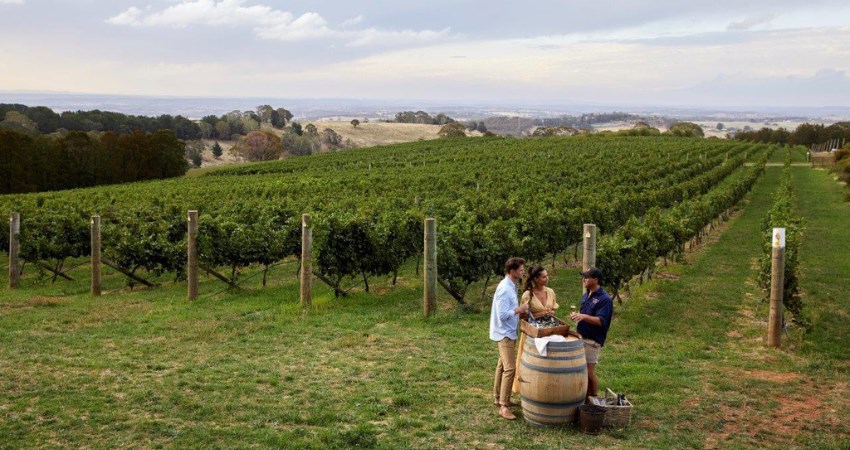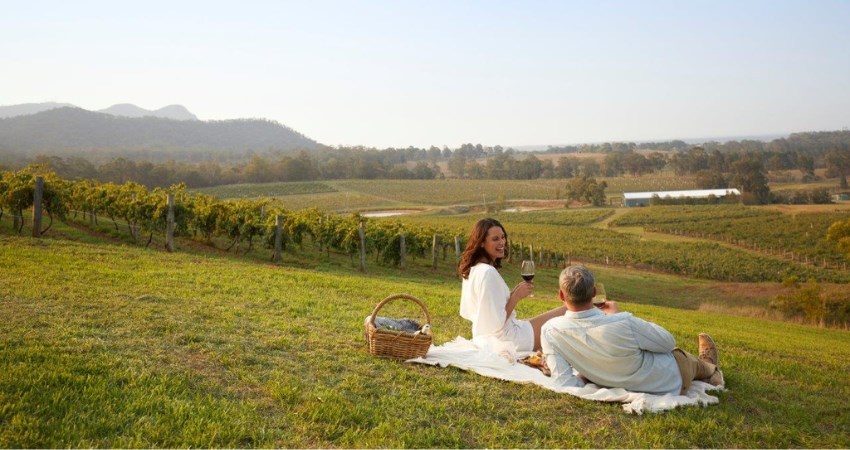
Orange Winery, New South Wales.
"We have a major job to do, rebuilding tourism and aviation infrastructure after the pandemic. After ten years of growth we fell off a cliff," declares Phillipa Harrison, MD of Tourism Australia. She was speaking at ATE23, the annual Australian Tourism Exchange, the biggest travel show in the southern hemisphere, attended by 2300 delegates and eighty journalists from 32 countries. The five-day showcase on Queensland’s iconic Gold Coast signalled the post-Covid tourism recovery is well underway.
The tasks of rebuilding tourism markets and key trends in the post-pandemic recovery offer key lessons for South Africa and other long-haul destinations. While international visitation from key global markets is slowly bouncing back for Tourism Australia, a full recovery to pre-Covid levels is only predicted by 2025 with a return to good growth to 2030. While the biggest recovery has been in VFR (visiting friends and relatives), consumers are missing and prioritising travel on discretionary income, especially high-income travellers – whereas low-income travel (especially the backpacker industry on long-term working visas in the hospitality and agri-sectors) is trending flat.
Good food and wine is one of the key ten associations identified by "have vs haven’t visited" travellers to Australia – ranked in surveys by tourist attractions of aquatic and coastal, across wildlife, natural beauty, family-friendly, sustainable tourism, friendly locals, native and indigenous experiences, vibrant city lifestyles, good food and wine, and lastly value for money. Stimulating consumer confidence in travel and creating consumer demand – through global media campaigns like the new "Come and say G'Day" campaign led by actress Rose Byrne – are two key strategies.
At the opening press conference Phillipa Harrison emphasised that Australia is still very competitive, and that recovery is robust, attracting 9.5 million visitors per annum, ranked at #7 in world travel spend. Rebuilding aviation capacity is critical in bringing back tourism through increasing direct international flights to regional hubs such as Brisbane and Cairns. One of the key factors in the post-pandemic recovery is increased competition among carriers and lower fares on international routes to long-haul destinations such as Australia (and South Africa).
Importantly, the post-pandemic travel and tourism market is a new country altogether. Tourism Australia consumer research highlights eight key emerging trends. The key growth points show that Covid health concerns over travel have shifted to wealth concerns; growing consumer demand from high-yield travellers for luxury food, wine and accommodation; increased demand for "purposeful feel-good travel" for wellness, nature and adventure tourism; physically accessible tourism; longer terms stays by digital nomads (one in five travellers stay for a month a more); a shift to "discovery" (inspiration) holiday planning; and that travel has reached a technological inflexion point (curve).
It's a lot to take in. But inspiring and converting travel dreams to actual visitation is the name of the game. Over-delivering on expectations is vital, especially when it comes to food and wine tourism. A key strategy for Tourism Australia is based on their findings that show the intention to book a trip increases substantially when travellers are exposed to a diversity of experiences through campaigns across global media platforms – especially when paired with a key tourism experience such as the natural environment and landscape, unique wildlife, agritourism and indigenous Australian experiences inspired by storytellers. Storytelling is critical to the tourism narrative today.
ATE23 focused on three critical areas of tourism. Firstly, the high consumer demand for accessibility (24% of travellers to Australia have a special accessibility need or health concern – and 86% say accessibility influences their choice of destination). Second, 49% of visitors emphasise the need for meaningful sustainable tourism as the right and moral thing to do as it reflects how they live in their normal day-to-day life – and will enable future generations to travel.Thirdly, the huge growth in demand for indigenous-led tourism experiences and encounters (see www.australia.com).
Accessibility, sustainability and "mindful travel" was also a key focus for Queensland, which hosted ATE23. Trish Callaghan, CEO of Tourism and Events Queensland, commented: "The consumer landscape is changing, turning to sustainable travel that leaves a legacy for those to come. Queensland did not stand still while our borders were closed by Covid. We’re transforming the plethora of experiences in the whole state as a leisure and lifestyle destination to meet demand for an experience-driven market and off-the-beaten track destination."
The year 2023 is "the year of inclusive and accessible tourism" in Queensland, which is on a ten-year planning and building countdown as the forthcoming host of the 2032 Olympics and Paralympic Games.
Ultimate Winery Experiences Australia, one of the signature collections of the best of the best wineries, luxury lodges, great fishing, golf, walks, wildlife journeys, landscapes and cultural attractions of Australia, is one of the key marketing strategies backed by Tourism Australia over the last decade. Since attending the launch of Ultimate Winery Experiences Australia in 2013, I have visited sixteen of the 27 iconic wineries spearheading the initiative. Handpicking an A-list of wineries from some 1500 cellars spread across 65 wine regions in Australia is no easy task. UWEA aims to raise the profile of Australia as one of the world’s leading wine tourism destinations. Selection criteria include unique location and heritage, world-class facilities to cater to international visitors, and innovative tastings, vineyard, gastronomy and hospitality experiences beyond the cellar door.
When it comes to food and wine tourism, I was delighted to discover Kiff and Culture, an award-winning tourism operator on the Gold Coast started by expatriate South African entrepreneur Drew Campbell. On a tour of local food hotspots, we visited one of the many burgeoning craft gin, rum and whisky distilleries called Granddad Jack’s Distillery, a celebrated producer which cheekily took on the global Jack (you know who) US whiskey corporation over trademarks in a David and Goliath battle of legal proportions – and proudly tells the story today.
Wine tourism regions from around Australia were among the hundreds of exhibitors at ATE23, meeting buyers and delegates from around the world. From Hunter Valley in New South Wales and the Barossa in South Australia, the birthplaces of wine tourism in Australia in the 1970s, to the Mornington and Yarra wine regions in Victoria, cool-climate Canberra, Margaret River in WA and Tasmania, it was business as usual in the marketplace at ATE23.

Audrey Wilkinson Winery, Hunter Valley, New South Wales.
Although Queensland is better known for its iconic beaches, Great Barrier Reef, tropical rain forests and vast Outback, it is also home to a cool climate, high altitude wine region known as the granite belt described by Wine Australia as "one of the most exciting and under-rated wine regions in Australia". One of my most fascinating finds was the "strange birds wine trail", one of the 650 tourism attractions in Queensland showcased at ATE23. The only wine route in the world to focus on "non-signature" wine varieties, it is branded after alternate (defined as less than 1% of Australian bearing vines) or emerging varieties at 23 boutique cellars around Stanthorpe first planted in the 1870s.
An ingenious innovation in wine tourism, the strange bird wine trail (patented) eschews the normal marketing of hero or signature varietals by wine regions. Instead it showcases 40 lesser known varieties planted in the granite belt – alternate white varieties known to South Africa too such as Albarino, Gruner Veltliner, Malvasia, Manseng, Marsanne, Roussanne, Savagnin, Sylvaner, Verdelho, Vermentino and Viognier. And strange red birds like Barbera, Carmenere, Durif, Malbec, Mourvedre, Nebbiolo, Nero d'Avola, Pinotage, Sangiovese, Tannat, Tempranillo, and loads more coming soon. See Granite Belt Wine Country's website for a strange bird wine guide, map and tasting wheel. In an era of global warming and climate change, drought and disease-resistant grape varieties are the rage.
The concept of an alternate wine variety region took root when Angelo Puglisi, owner of Ballandean estate (1932), home to some of Australia’s oldest Shiraz vines, planted his first strange bird variety, Malbec, back in 1984. Today, the estate in the heart of the granite belt grows and produces wines made from Durif, Fiano (Campagnia), Malvasia (Croatia), Nebbiolo, Saperavi (Georgia) and Viognier. Mike Hayes, winemaker at Balancing Heart Wines also in the granite belt, a man with over forty vintages under his belt, named Australian winemaker of the year in 2017, has made Carmenere, Sagrantino (Umbria), Pinot Grigio, Vermentino and Petit Verdot. A great day trip out from Brisbane.
At ATE23, I also caught up with exhibitor Alva Henning, marketing manager for Go Beyond Melbourne, a food and wine tourism initiative which links four regions renowned for their food and wine attractions from Mornington and Yarra Valleys to Geelong, the Bellarine and Phillip Island.
One of the many innovative wine tourism initiatives in the boutique art, food and wine cellars of Mornington Peninsula, Trofeo (meaning trophy in Italian), specialises in the exclusive production of amphora wines using organic, biodynamic and vegan-friendly viticulture. Branded as the biggest producer of amphora wines in the southern hemisphere, the wines are all made using terracotta amphora from Chianti, Italy – winning winemaker Richard Darby a five-star rating by James Halliday. Tasting trails, paddock to plate (or farm gate to fork) dining experiences combine diverse tourist attractions from cellar-door, craft distillery, brewery and cider-tastings to artisanal food producers.
While travelling through Queensland, I spotted strange bird (alternate) varieties, organic/biodynamic, wild ferment and amphora wines as special categories on wine lists created by leading sommeliers at fine dining restaurants in Surfer’s Paradise on the Gold Coast and in Cairns and Port Douglas. Food (and wine) for thought as innovations on local South African wine lists closer to home. I spent the next fortnight exploring the brave new world of environmental, food and wine tourism down under.